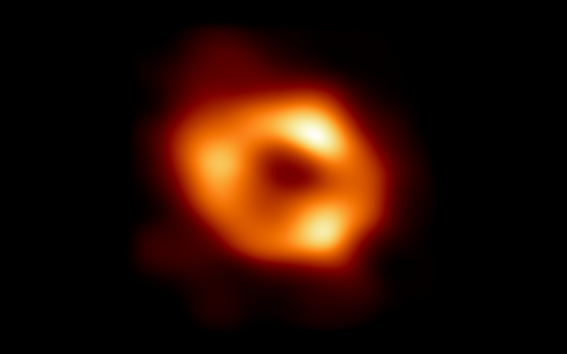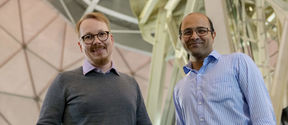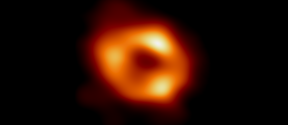Researchers’ bio
Researchers from Aalto University, University of Turku, and Finnish Centre for Astronomy with ESO participated the project taking a photo of the black hole at the centre of our galaxy.

What is a black hole?
Black hole is the name given to an area of spacetime in which gravity is so strong that no particles, or even electromagnetic radiation, can escape it. The threshold that surrounds a black hole, behind which escape is impossible, is called the event horizon. Inside the event horizon the curving of space caused by the gravity of the black hole is so extreme that the hole excludes itself from the surrounding universe, as it were.
A black hole is created when a sufficiently large mass is compressed into a very small volume – to turn our own Sun into a black hole, it would have to be compressed to a radius of about three kilometres. Astronomers have found two types of black holes in space: stellar black holes which are formed when the internal parts of a massive star collapse in a supernova explosion, and so-called supermassive black holes located in the centre of galaxies. Supermassive black holes can weigh billions of times as much as the Sun.
What is the Event Horizon Telescope?
The Event Horizon Telescope (EHT) is an international cooperative project established to produce history's first image of a black hole, using Very Long Baseline Interferometry (VLBI). It is a technique in which radio telescopes in different locations around the Earth are combined to form as accurate an image of a distant object as possible. The combined resolution of these telescopes is the same as that of a single telescope the size of the Earth. In addition to Aalto University and the University of Turku, EHT has about 100 organisations around the world engaged in research, with more than 350 researchers involved. The project gets funding from several dozen sources. In Finland, the research required by the project has received funding from the Academy of Finland.
The Event Horizon Telescope has examined a black hole called the Sagittarius A*, which is in the centre of our Milky Way. It has the mass of four million suns and is located 27,000 light years from Earth. The first image of a black hole was taken with a different target of research in mind. A black hole in the middle of the M87 galaxy was chosen as the target because owing to its greater mass (six billion solar masses), the ostensible size of its event horizon in the sky was at about the same level as that of Sagittarius A*, even though it is located much further – 55 million light years away. The larger size of its event horizon made M87 easier to image than Sagittarius A* because the time that the radiant gas takes to orbit the black hole depends on the black hole's size. With M87 this orbit time is long compared to the “exposure time” of a picture taken by EHT, which is about 8-12 hours, depending on the target. The orbit time of the radiant gas in Sagittarius A* around the hole is just minutes, which causes the target to change during the “exposure”, posing challenges for picture formation. EHT researchers have nevertheless succeeded in developing methods that have overcome these challenges, and an image of Sagittarius A* now exists.
What is ESO and what is its significance in this research?
Finland became a member of ESO, the European Southern Observatory, on 7 July 2004. The goal of ESO, which was founded in 1962, is to reinforce and organise cooperation in astronomy research. ESO has its headquarters in Garching, Germany, and it operates three top-level observatories in Chile. ESO currently has 15 member countries.
Aalto University, the University of Turku, the University of Helsinki, and the University of Oulu set up a new national research institute for the study of astronomy, the Finnish Centre for Astronomy with ESO (FINCA), in 2010. The centre is located at the Tuorla Observatory. The ESO membership dues have been budgeted through the Academy of Finland.
How is it possible to photograph a black hole when black holes do not emit light?
As their name suggests, black holes themselves do not radiate. However, the environment of a black hole can emit powerful radiation if gas falls into the black hole. As gas orbits the hole at a fast speed, it gets extremely hot and radiates. The gravity field of a black hole causes the course of this light to bend, causing some of the photons to orbit the hole. The result is a bright ring, in the middle of which a dark cloud can be seen – the silhouette of the event horizon. The shadow is about two and a half times bigger than the event horizon itself and its size depends mainly on the mass of the black hole and to a lesser degree, on how fast the hole rotates.
What is an event horizon?
An event horizon is the threshold surrounding a black hole, inside which the black hole pulls everything into itself, including light. This is referred to as the event horizon of a black hole.
What is the point of studying black holes?
The extreme gravitational field of a black hole makes it possible to test Einstein's general theory of relativity – one of the cornerstones of modern physics – in conditions that cannot be found on our earthly laboratories, and not even in our own solar system.
The general theory of relativity describes gravity as the curvature of spacetime and in the past 100 years it has easily withstood all experimental tests. For ordinary people the general theory of relativity is easiest to see in the use of GPS navigation, which is familiar to us from our smartphones. If the theory of relativity were not considered in the clocks in GPS satellites, the positioning error in the system would grow significantly in a single day.
However, it is not at all clear that this theory of relativity would also be applicable to very strong gravitational fields, such as those near black holes. A possible deviation from predictions based on the theory of relativity could lead physicists further toward a theory describing the universe.
In addition to testing the general theory of relativity, the Event Horizon Telescope also enables the study of the behaviour of gas that falls into a black hole in the immediate proximity of the event horizon. This is expected to give answers to mysteries such as the origins of the gigantic plasma jets caused by supermassive black holes.
How is a picture of a black hole taken?
The problem with recording an image of the shadow of a black hole is its small size. Even the biggest black holes would fit inside our solar system, and as they are located at such long distances to us that seeing the shadow would require an observation device that has a couple of thousand times sharper view than the Hubble space telescope. The images that we now have were enabled by the development of technology, equipment, and methods of analysis.
In 2017, eight radio telescopes on the tops of mountains in Chile, Mexico, Hawaii, Arizona, Spain, and Antarctica recorded images of the M87 and Sagittarius A* black holes for a five-day period. Using a technology known as Very Long Baseline Interferometry (VLBI) these telescopes were linked with each other to form a single gigantic virtual telescope. It is nearly the size of the Earth, and it is so precise that the resolution would allow enable someone in Helsinki to read a newspaper in the Canary Islands.
Getting an image from the Event Horizon Telescope has required extremely detailed synchronisation of these eight radio telescopes, which is why extremely precise atomic clocks have been installed in each of them. The signals of the telescopes have been recorded on a thousand specially produced hard discs which have been taken to eight supercomputers after the observations were made for combining the signals. After this, an image has had to be calculated from the combined signal. This has also not been easy, as an interferometer of the Event Horizon Telescope type will not form a direct image in the way that a camera does, for example. As there are only a few radio telescopes in the network, making observations through the network is like trying to take a picture with a telescope whose mirror is intact only in a few small places. Consequently, producing an image requires advanced algorithms and researchers have had to take extreme care to ensure that the image is correct.
Will images of a black hole be an everyday occurrence in the future?
Unfortunately, we do not yet know of any other supermassive black holes that would be sufficiently massive and close enough to us that their ostensible size in the sky would be sufficient to produce an image. However, the search is ongoing, and not all hope is lost in this respect. The resolution of the EHT could be improved in the future by sending an antenna into space. This would also make it possible to get images of slightly smaller black holes.
What is the significance of Aalto University's Metsähovi Radio Observatory in this research?
Metsähovi is Finland's only astronomical radio observatory. The observatory, which operates as a separate unit of the Aalto University School of Electrical Engineering, is in Kirkkonummi, about 30 kilometres from the Otaniemi campus. It is one of the large infrastructures of Aalto University research and instruction. The main instrument of Metsähovi, a 14-metre radio telescope, is in use around the clock on every day of the year, and the observational data that it produces is used in studying active galaxies, the sun, and the rotation of the earth, among other things.
The Metsähovi radio telescope has not been involved in collecting data for the Event Horizon Telescope project, because the Metsähovi radio telescope operates on radio waves with a wavelength that is slightly longer than the 1.3 millimetres required by the EHT project. Tuomas Savolainen, a senior scientist at Aalto University's Metsähovi Radio Observatory and at the Department of Electronics and Nanoengineering, and Venkatessh Ramakrishnan, a postdoctoral researcher working at Metsähovi and for the Finnish Centre for Astronomy with ESO (FINCA), are part of the EHT community of researchers, and they were involved in analysing the combined data of the eight different telescopes and forming an image of the black hole based on the data.
Metsähovi has also taken part in the development of observation techniques used by EHT at millimetre wavelengths already in the early stages of the development work in the 1990s. At that time Very Long Baseline Interferometry (VLBI) experiments were conducted at wavelengths of 2 and 3 millimetres. Today Metsähovi is part of a network conducting regular VLBI observations at a wavelength of 3 millimetres.

Researchers from Aalto University, University of Turku, and Finnish Centre for Astronomy with ESO participated the project taking a photo of the black hole at the centre of our galaxy.

Researchers from Aalto University, the University of Turku and the Finnish Centre for Astronomy with ESO were part of the international research group in taking a revolutionary picture.



